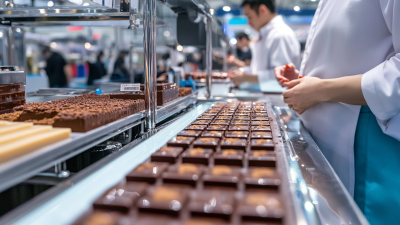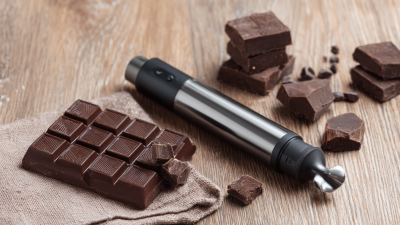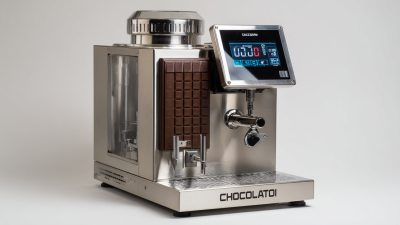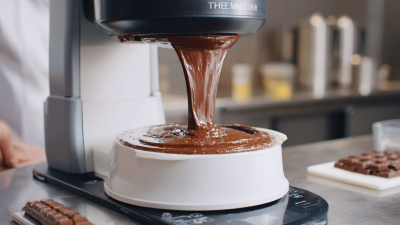In the world of chocolate making, achieving the perfect balance of flavor and texture is an art form, and one of the essential techniques involved is chocolate tempering. This process, which involves carefully heating and cooling chocolate, ensures that it solidifies with a glossy finish and a satisfying snap.
 A key player in this meticulous method is the "temperatrice di cioccolato," a specialized chocolate tempering machine designed to control temperature fluctuations accurately. By understanding how this innovative equipment influences the tempering process, chocolatiers can unlock deeper flavors and improve the overall texture of their creations. This article will delve into the nuances of chocolate tempering, exploring how the temperatrice di cioccolato not only enhances the quality of chocolate but also elevates the confectionery experience to new heights.
A key player in this meticulous method is the "temperatrice di cioccolato," a specialized chocolate tempering machine designed to control temperature fluctuations accurately. By understanding how this innovative equipment influences the tempering process, chocolatiers can unlock deeper flavors and improve the overall texture of their creations. This article will delve into the nuances of chocolate tempering, exploring how the temperatrice di cioccolato not only enhances the quality of chocolate but also elevates the confectionery experience to new heights.
Tempering chocolate is a crucial process that affects both flavor and texture, and it all comes down to the science of crystalline structures. When chocolate is tempered correctly, it develops a stable form of cocoa butter crystals, specifically the beta crystals, which contribute to chocolate's glossy appearance and satisfying snap. This transformation enhances the mouthfeel and overall sensory experience, making each bite more enjoyable. Understanding these crystalline structures is key for any chocolatier aiming to create high-quality confections.
Tip: To achieve the perfect temper, start by melting chocolate to around 115°F (46°C) for dark chocolate or 110°F (43°C) for milk and white chocolates. Then, cool it down by adding small pieces of solid chocolate, stirring constantly until it reaches about 82°F (28°C). This step encourages the formation of stable crystals.
Moreover, the tempering process not only affects aesthetics but also impacts the shelf life of the chocolate. Properly tempered chocolate resists bloom, ensuring that your creations maintain their allure over time. This is particularly important for artisanal chocolates which often showcase unique flavor profiles developed through careful sourcing and processing.
Tip: Always use a thermometer to monitor temperatures accurately. This can help capture the ideal moment for pouring your tempered chocolate into molds or for enrobing your favorite treats.
Achieving the perfect chocolate tempering requires not only skill and technique but also the right equipment. Essential tools include a reliable thermometer, which helps monitor the chocolate's temperature closely, ensuring it doesn’t overheat. A silicone spatula is invaluable for stirring, allowing for even distribution of heat and facilitating a smooth, glossy finish in the tempered chocolate. Additionally, using a marble slab can provide a cool surface for tabling, which is a traditional technique to seed the chocolate and encourage proper crystallization.
Another crucial piece of equipment is the double boiler or a tempering machine, which offers controlled heating and cooling. A double boiler allows for gentle heat application, preventing seizing or burning of the chocolate, while a tempering machine automates the process and ensures consistent results. Having these essential tools at your disposal not only enhances the efficiency of the tempering process but also plays a significant role in elevating the flavor and texture of the final chocolate product. Overall, investing in quality equipment lays the foundation for successful chocolate work.
Tempering chocolate is an essential process that ensures a desirable sheen, snap, and mouthfeel in confections. According to the Fine Chocolate Industry Association, well-tempered chocolate can enhance flavor profiles and promote better texture, permitting a smoother melt on the palate. With the right method, whether it be the seeding technique or the tabling method, chocolatiers can achieve the perfect crystallization of cocoa butter fats, which accounts for the glossy finish and crisp consistency that consumers often seek.
The seeding technique involves adding tempered chocolate to melted chocolate, allowing the stable crystals to instigate uniform crystallization. This is especially effective for those looking to temper smaller batches. On the other hand, the tabling method requires working chocolate on a cool surface, manipulating it until it reaches the right temperature and consistency. Research indicates that properly tempered chocolate has a higher shelf life—up to 10% longer—while maintaining stable polymorphs. Selecting the right tempering technique can not only elevate the overall quality of the chocolate but also significantly affect production efficiencies in commercial settings.

The magic of chocolate begins not just with its ingredients but significantly through the art of tempering. The process of tempering, particularly using the technique of "temperatrice di cioccolato", is crucial for controlling the temperature during chocolate production. A well-executed tempering process can elevate the final product, impacting both flavor and texture. According to a report by the Chocolate Manufacturers Association, properly tempered chocolate can exhibit a sheen that indicates a stable crystalline structure, which enhances mouthfeel by delivering a smooth and creamy texture.

Temperature control during chocolate tempering also influences the development of flavor compounds. Research published in the Journal of Agricultural and Food Chemistry reveals that specific temperature thresholds during the melting and cooling phases can optimize the Maillard reaction, which is responsible for the complex flavors in chocolate. For example, maintaining a consistent temperature of around 32°C (89.6°F) during the tempering process allows for the ideal crystallization of cocoa butter, resulting in a more pronounced cocoa flavor. This intricate balance of temperature not only synergizes with the inherent flavors of the cocoa beans but also ensures that the chocolate melts perfectly on the palate, creating an exceptional tasting experience.
Tempering chocolate is essential for achieving that glossy finish and satisfying snap, yet many home cooks struggle with common mistakes that can derail the process. One prevalent issue is overheating the chocolate. Using high, uncontrolled heat can result in burnt chocolate, ruining its flavor and texture. To avoid this, always temper chocolate over a gentle heat source, such as a double boiler, and keep a thermometer handy to maintain ideal temperatures.
Another common mistake is not properly seeding the chocolate with cocoa butter or tempered chocolate. This method ensures the right crystalline structure, which is key to a smooth texture. To effectively seed, finely chop some previously tempered chocolate and gradually stir it into the melted chocolate, allowing it to cool while maintaining the proper consistency.
**Tips for Successful Tempering:**
- Always use high-quality chocolate, as it melts and tempers better.
- If using a microwave, heat in short intervals, stirring in between to prevent overheating.
- Practice patience and take your time, as rushing the process can lead to undesirable results. By being mindful of these mistakes and following these tips, you can unlock the true potential of your chocolate.
| Aspect | Description | Common Mistakes | Tips to Avoid Mistakes |
|---|---|---|---|
| Temperature Control | Maintaining specific temperature ranges during tempering. | Using incorrect temperature settings. | Use a reliable thermometer and monitor closely. |
| Methods of Tempering | Different techniques such as tabling, seeding, and microwave method. | Skipping steps in the tempering process. | Follow the chosen method step by step without rushing. |
| Humidity Control | Maintaining a low humidity environment during tempering. | Ignoring humidity effects on chocolate. | Work in a climate-controlled environment if possible. |
| Quality of Chocolate | Using high-quality chocolate for the best results. | Using subpar chocolate. | Choose chocolate with a high cocoa content and good ingredients. |
| Cooling Process | Properly cooling chocolate after tempering. | Cooling too quickly or inadequately. | Allow it to cool gradually at room temperature. |






Utilizziamo i cookie per migliorare l'esperienza utente. Per maggiori informazioni, consulta la nostra Cookie Policy.